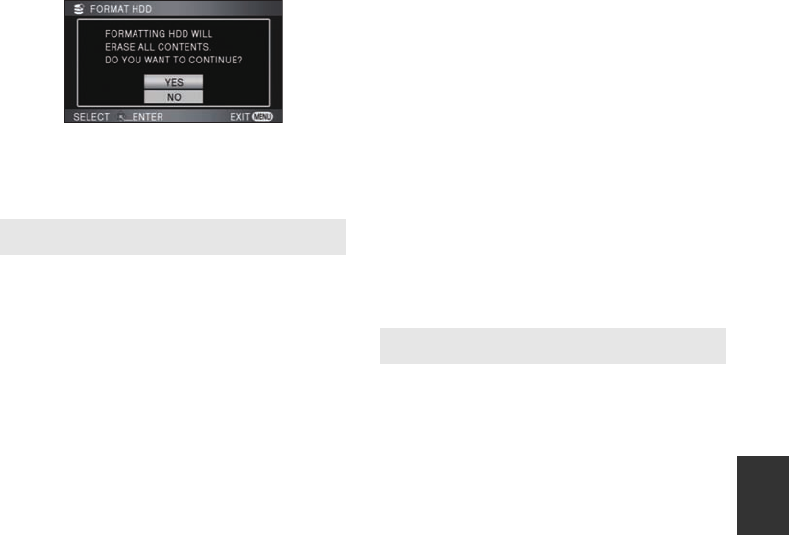
141
VQT1T93
When disposing of or giving away this unit,
note that:
≥ Formatting and deletion simply change the file
management information and cannot be used
to completely erase the data in HDD of this
unit. The data can be recovered using
commercially available software or the like.
≥ We recommend that you physically format the
HDD before disposing of or giving away this
unit. To physically format the HDD, connect the
unit via the AC adaptor, select [FORMAT HDD]
# [YES] from the menu, and then press and
hold the delete button on the screen below for
about 3 seconds. When the HDD data deletion
screen appears, select [YES], and then follow
the on-screen instructions.
≥ Please look after the data in your HDD
carefully. Panasonic will not be held
responsible in the unlikely case that private
data is divulged.
The battery used in this unit is a rechargeable
lithium-ion battery. It is susceptible to humidity
and temperature and the effect increases the
more the temperature rises or falls. In cold areas,
the full charge indication may not appear or the
low battery indication may appear about
5 minutes after starting use. At high
temperatures, the protection function may be
triggered, making it impossible to use the unit.
Be sure to detach the battery after use.
≥ If the battery is left attached, a minute amount
of current continues to flow even if the unit’s
power is off. Keeping the unit in this state may
result in over discharge of the battery. This
may result in you not being able to use the
battery even after it is charged.
≥ The battery should be stored in the vinyl bag
so metal does not come into contact with the
terminals.
≥ The battery should be stored in a cool place
free from humidity, with as constant
temperature as possible. (Recommended
temperature: 15 °C to 25 °C (59 °F to 77 °F),
Recommended humidity: 40% to 60%)
≥ Extremely high temperatures or low
temperatures will shorten the life of the battery.
≥ If the battery is kept in high-temperature, high-
humidity, or oily-smoky places, the terminals
may rust and cause malfunctions.
≥ To store the battery for a long period of time,
we recommend you charge it once every year
and store it again after you have completely
used up the charged capacity.
≥ Dust and other matter attached to the battery
terminals should be removed.
Prepare spare batteries when going out for
recording.
≥ Prepare batteries enough to last for 3 to 4
times the period you are planning to record for.
Cold places such as a ski resort can shorten
recording time.
If you drop the battery accidentally, check to
see if the terminals are damaged.
≥ Attaching a battery with damaged terminals
can damage the unit or AC adaptor.
Do not throw old battery into fire.
≥ Heating a battery or throwing it into a fire may
result in an explosion.
If the operating time is very short even after
the battery has been recharged, the battery
has worn out. Please purchase a new battery.
≥ If the temperature of the battery is extremely
high or extremely low, charging may take time
or the battery may not be charged.
≥ If the charging lamp keeps flashing, make sure
that the terminals of the battery or the AC
adaptor are not exposed to dirt, foreign objects
or dust, then reconnect them properly.
Disconnect the AC cable from the AC outlet
when you remove dirt, foreign objects or dust
on the terminals of the battery or the AC
adaptor.
If the charging lamp is still flashing, the
temperature of the battery may be extremely
high or extremely low or something may be
wrong with the battery or AC adaptor. Contact
consumer support. (l 153, 154).
≥ If you use the AC adaptor near a radio, radio
reception may be disturbed. Keep the AC
About the battery
About the AC adaptor
HDCHS100P-VQT1T93_ENG.book 141 ページ 2008年7月14日 月曜日 午後1時36分


















